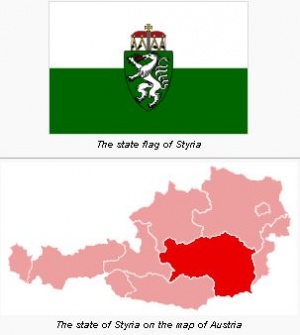Styria (Austria)

Styria (German: Steiermark), a province of Austria, capital Graz, in the 16th and 17th centuries administratively closely allied to Carinthia as "Inner Austria." Although Lutheranism was eagerly embraced in Styria by both nobility and burghers from its very beginning, Anabaptism never had a strong development there, perhaps in part because of the lack of significant leaders. In the days of the Governor Siegmund of Dietrichstein, 1515-1529, an ardent Lutheran, Protestantism spread quickly across the country in spite of the passionate efforts of King Ferdinand I to stem the tide. Not much is known about the origins of Anabaptism in Styria. The preacher Hans Has (Haas) of Windisch-Gräz, who was beheaded in 1527, can hardly be called an Anabaptist even though his fine "Sendbrief an die Auserwählten" (comfort in persecution) is found in the Kunstbuch of the Marpeck group. It was about this time, 1527-1529, that Anabaptism was strongest everywhere. Single Anabaptists are reported in many places such as Rottenmann, Leoben, Brück an der Mur, Hartberg, and Graz. Although the Lutherans were quite defiant toward the Hapsburg government of Vienna in their own affairs, they eagerly co-operated in the suppression of the Anabaptist "heresy," and Dietrichstein was particularly conspicuous in this regard. The most tragic event was the martyrdom of nine Anabaptist brethren and three sisters in the city of Brück an der Mur in 1528. The Lieder der Hutterischen Brüder (25-27) contains a well-known hymn commemorating this sad event; the hymn is anonymous, but it appears fairly certain that it was composed by Hans Gurtzham, of whom the Lieder brings another almost identical hymn (136 f.) (See also Wackernagel, Kirchenlied III, 467 f.) Soon the Anabaptists began the exodus to Moravia, "the promised land."
The next governor of Styria (after 1530), Hans Ungnad von Sonneck, also a Lutheran, stands out as a very lenient and tolerant ruler. To be sure, he had to obey an order by King Ferdinand and tear down the house of Kaspar Maler of Graz, an Anabaptist who had previously arranged meetings in his house but had now gone to Moravia. But Ungnad could boast of having shed no blood; he is reported to have said that he did not want to have anything to do with the Anabaptists, for they were God-fearing, simple people. There was, however, another mass execution in Graz in 1534, the martyrdom of the important Daniel Kropf, with two other brothers and four sisters. But it seems that it was not Ungnad but his assistant, the Vicedomus Michael Meixner, who passed that sentence. It is quite probable that the events of Münster had an unfavorable influence even in Styria. Although records continue to mention Anabaptists here and there, it is quite obvious that no real church life developed at any place; there were rather single individuals, in most cases on their way to Moravia. All in all, the Hutterite Chronicle records (up to 1542) 25 executions for Styria - 7 in Graz, 12 in Brück, one in Unzmarkt, and 5 in Grichsbach.
Toward the end of the 16th century the Hutterite physicians and barber-surgeons were highly appreciated by the nobility (see Physicians, Hutterite). Thus, for instance, Elizabeth of Zägl in Friedau "lent" her Anabaptist doctor to her cousin Siegmund of Eibiswald for a fortnight (1590). And as late as 1613 the Abbot Johann of Admont received official permission from the provincial government to call a famous Anabaptist physician of Nikolsburg (see Goller) and he issued a passport for his safe conduct. Otherwise, however, Styria played only a marginal role in the history of Anabaptism.
Bibliography
Die Lieder der Hutterischen Brüder: Gesangbuch darinnen viel und mancherlei schöne Betrachtungen, Lehren, Vermahnungen, Lobgesänge und Glaubensbekenntnisse, von vielen Liebhabern Gottes gedichtet und aus vielen Geschichten und Historien der heiligen Schrift zusammengetragen, allen frommen Liebhabern Gottes sehr nützlich zu singen und zu lesen. Scottdale, Pennsylvania: Mennonitisches Verlagshaus, 1914. Reprinted Cayley, Alberta: Hutterischen Brüdern in Kanada, 1962, etc.
Dedic, Paul . “Märische Wiedertäuferärzte in der Steiermark.” Zeitschrift des Deutschen Vereins für die Geschichte von Mähren und Schlesien (1938): 22-27.
Dedic, Paul . “Reformation und Gegenreformation in Bruck an der Mur.” Jahrbuch der Geschichte für die Protestanten in Oesterreich LXIII-IV (1942-43): 15-23.
Loserth, Johann. “Anabaptists in Styria in 1528.” Mennonite Quarterly Review VII (1933): 133-41.
Loserth, Johann. “Wiedertäufer in Steiermark.” Mitteilungen des Historischen Vereins für Steiermark XLII (1894): 118-45.
Loserth, Johann. “Zur Geschichte der Wiedertäufer in der Steiermark” (third installment) in Zeitschrift des Historischen Vereins für Steiermark X (1912): 267-71.
Loserth, Johann. “Zur Geschichte der Wiedertäufer in Steiermark.” Mitteilungen des Historischen Vereins für Steiermark L (1903).
Mecenseffy, Grete. Geschichte des Protestantismus in Oesterreich. Graz, 1956.
Wackernagel, Philipp. Das deutsche Kirchenlied von der ältesten Zeit bis zu Anfang des XVII. Jahrhunderts, 5 vols. Leipzig, 1864-1877; Reprinted Hildesheim: G. Olms, 1964: 467.
Zieglschmid, A. J. F. Die älteste Chronik der Hutterischen Brüder: Ein Sprachdenkmal aus frühneuhochdeutscher Zeit Ithaca: Cayuga Press, 1943: 25-27.
| Author(s) | Grete Mecenseffy |
|---|---|
| Robert Friedmann | |
| Date Published | 1959 |
Cite This Article
MLA style
Mecenseffy, Grete and Robert Friedmann. "Styria (Austria)." Global Anabaptist Mennonite Encyclopedia Online. 1959. Web. 18 Dec 2024. https://gameo.org/index.php?title=Styria_(Austria)&oldid=143761.
APA style
Mecenseffy, Grete and Robert Friedmann. (1959). Styria (Austria). Global Anabaptist Mennonite Encyclopedia Online. Retrieved 18 December 2024, from https://gameo.org/index.php?title=Styria_(Austria)&oldid=143761.
Adapted by permission of Herald Press, Harrisonburg, Virginia, from Mennonite Encyclopedia, Vol. 4, pp. 651-652. All rights reserved.
©1996-2024 by the Global Anabaptist Mennonite Encyclopedia Online. All rights reserved.
